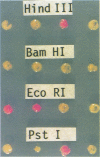Abstract
A gene (gshI) responsible for gamma-glutamylcysteine synthetase (GSH-I) activity was cloned to construct an Escherichia coli B strain having high glutathione synthesizing activity. For this purpose, two E. coli B mutants (strains C912 and RC912) were used. C912 was deficient in GSH-I activity. RC912, a revertant of C912, had a GSH-I activity that was desensitized to feedback inhibition of reduced glutathione. To clone gshI, chromosomal DNAs of RC912 and plasmid vector pBR322 were digested with various restriction endonucleases and then ligated with T4 DNA ligase. The whole ligation mixture was used to transform C912, and the transformants were selected as tetramethylthiuramdisulfide-resistant colonies. Of about 20 resistant colonies, 2 or 3 became red when treated with nitroprusside and showed appreciably high GSH-I activities. The chimeric plasmid DNA, designated pBR322-gshI, was isolated from the strain having the highest GSH-I activity and transformed into RC912. The structure and molecular size of pBR322-gshI in RC912 were determined. The molecular size of this plasmid was 6.2 megadaltons, and the plasmid contained a 3.4-megadalton segment derived from RC912 chromosomal DNA, which included gshI gene. The GSH-I activity of RC912 cells containing pBR322-gshI was fourfold higher than that of RC912 cells without pBR322-gshI.
Full text
PDF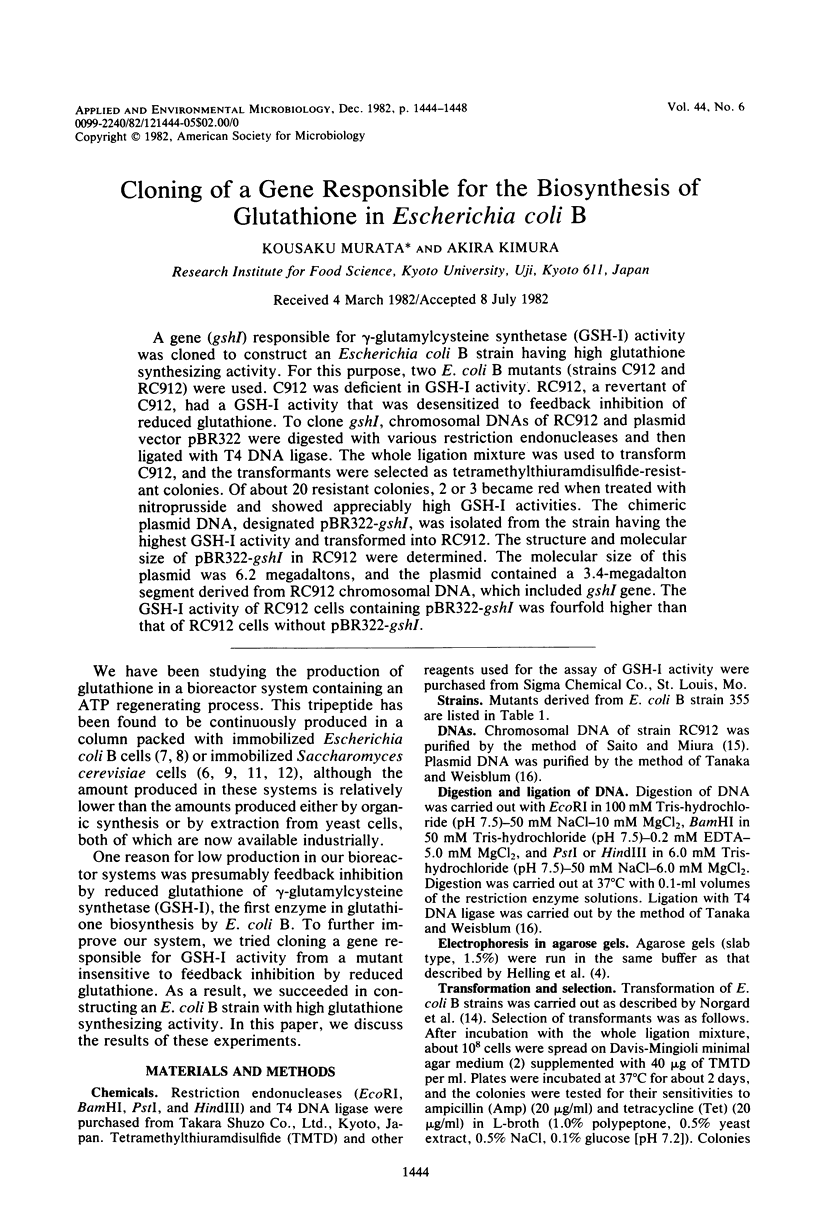
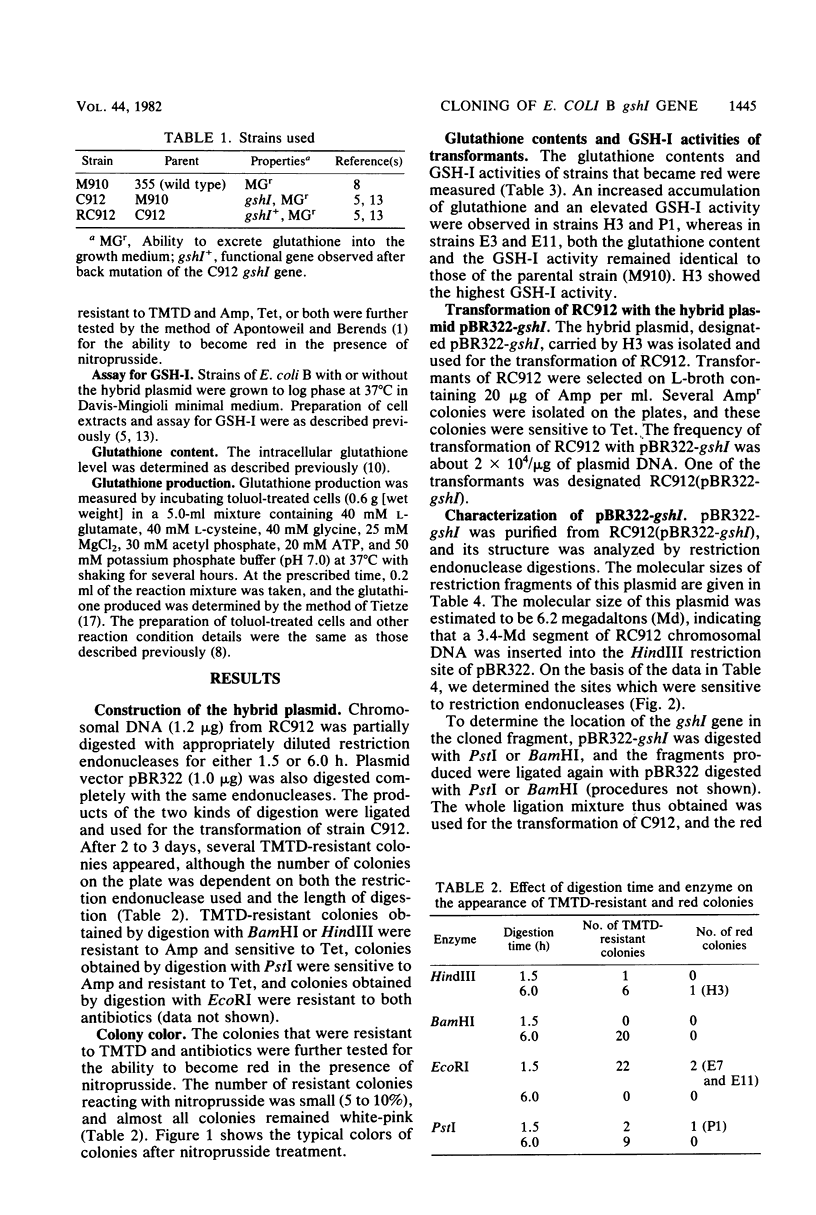
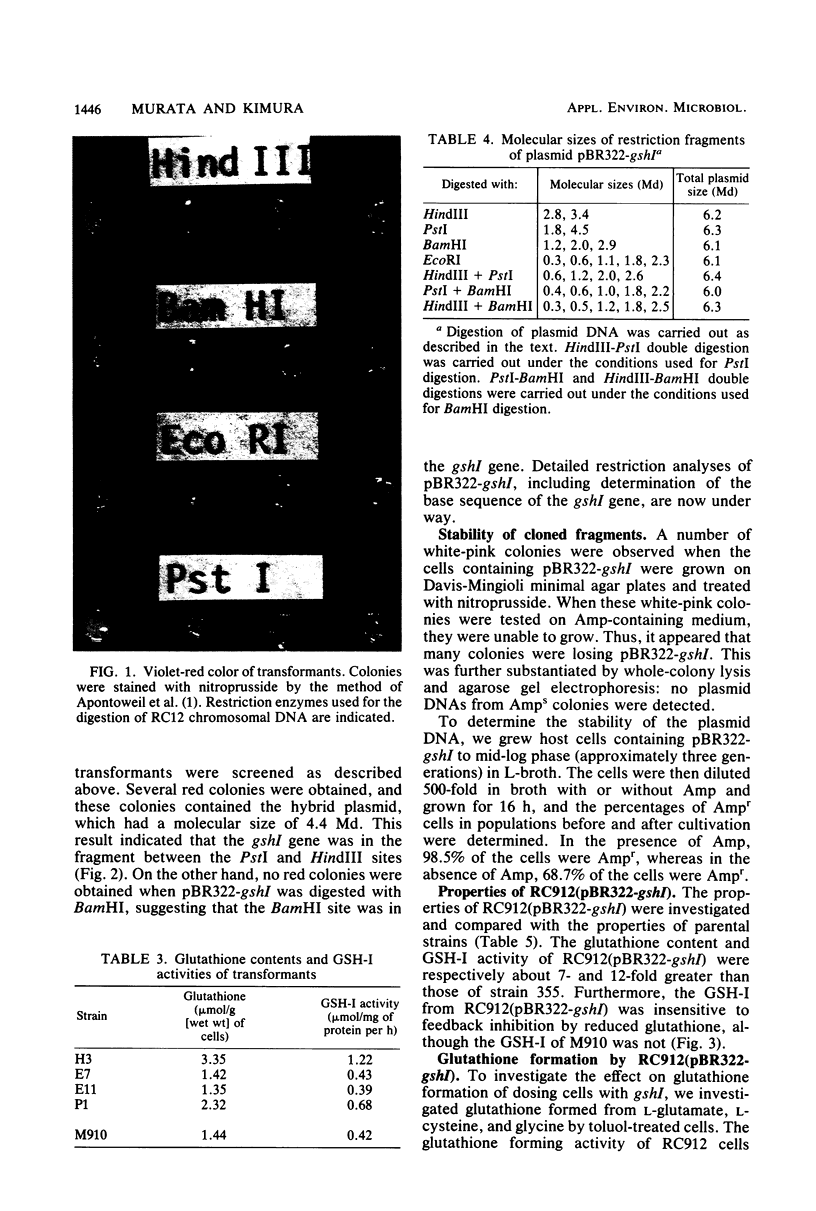
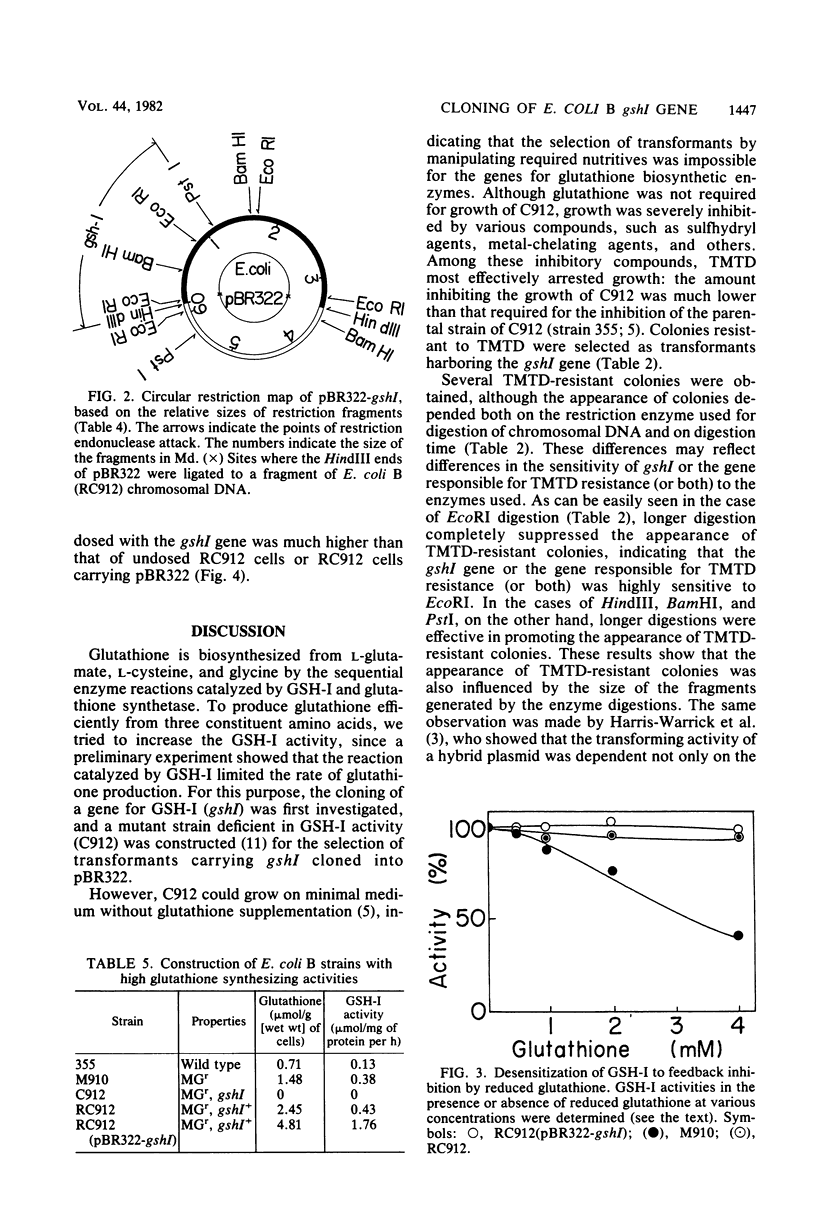
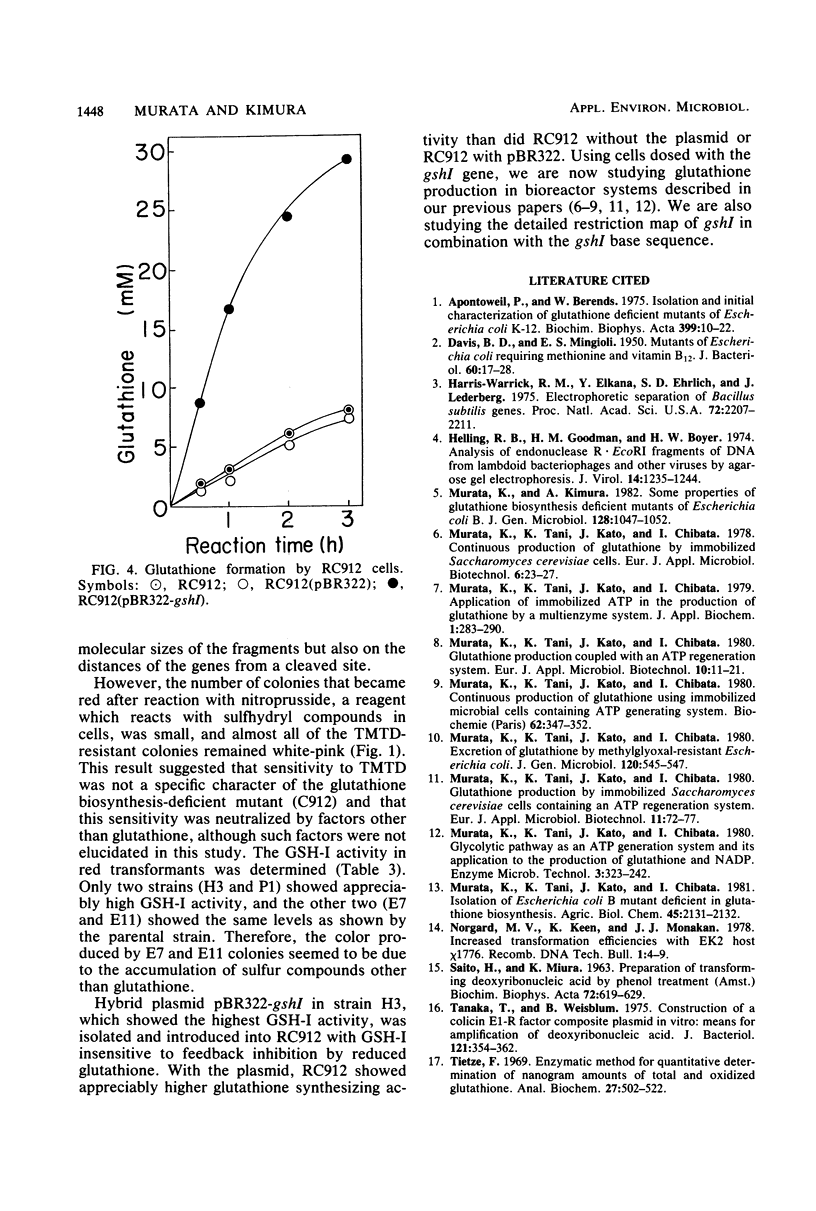
Images in this article
Selected References
These references are in PubMed. This may not be the complete list of references from this article.
- Apontoweil P., Berends W. Isolation and initial characterization of glutathione-deficient mutants of Escherichia coli K 12. Biochim Biophys Acta. 1975 Jul 14;399(1):10–22. doi: 10.1016/0304-4165(75)90206-8. [DOI] [PubMed] [Google Scholar]
- DAVIS B. D., MINGIOLI E. S. Mutants of Escherichia coli requiring methionine or vitamin B12. J Bacteriol. 1950 Jul;60(1):17–28. doi: 10.1128/jb.60.1.17-28.1950. [DOI] [PMC free article] [PubMed] [Google Scholar]
- Harris-Warrick R. M., Elkana Y., Ehrlich S. D., Lederberg J. Electrophoretic separation of Bacillus subtilis genes. Proc Natl Acad Sci U S A. 1975 Jun;72(6):2207–2211. doi: 10.1073/pnas.72.6.2207. [DOI] [PMC free article] [PubMed] [Google Scholar]
- Helling R. B., Goodman H. M., Boyer H. W. Analysis of endonuclease R-EcoRI fragments of DNA from lambdoid bacteriophages and other viruses by agarose-gel electrophoresis. J Virol. 1974 Nov;14(5):1235–1244. doi: 10.1128/jvi.14.5.1235-1244.1974. [DOI] [PMC free article] [PubMed] [Google Scholar]
- Murata K., Kimura A. Some properties of glutathione biosynthesis-deficient mutants of Escherichia coli B. J Gen Microbiol. 1982 May;128(5):1047–1052. doi: 10.1099/00221287-128-5-1047. [DOI] [PubMed] [Google Scholar]
- Murata K., Tani K., Kato J., Chibata I. Continuous production of glutathione using immobilized microbial cells containing ATP generating system. Biochimie. 1980;62(5-6):347–352. doi: 10.1016/s0300-9084(80)80164-7. [DOI] [PubMed] [Google Scholar]
- Murata K., Tani K., Kato J., Chibata I. Excretion of glutathione by methylglyoxal-resistant Escherichia coli. J Gen Microbiol. 1980 Oct;120(2):545–547. doi: 10.1099/00221287-120-2-545. [DOI] [PubMed] [Google Scholar]
- SAITO H., MIURA K. I. PREPARATION OF TRANSFORMING DEOXYRIBONUCLEIC ACID BY PHENOL TREATMENT. Biochim Biophys Acta. 1963 Aug 20;72:619–629. [PubMed] [Google Scholar]
- Tanaka T., Weisblum B. Construction of a colicin E1-R factor composite plasmid in vitro: means for amplification of deoxyribonucleic acid. J Bacteriol. 1975 Jan;121(1):354–362. doi: 10.1128/jb.121.1.354-362.1975. [DOI] [PMC free article] [PubMed] [Google Scholar]
- Tietze F. Enzymic method for quantitative determination of nanogram amounts of total and oxidized glutathione: applications to mammalian blood and other tissues. Anal Biochem. 1969 Mar;27(3):502–522. doi: 10.1016/0003-2697(69)90064-5. [DOI] [PubMed] [Google Scholar]



